This article is from the Australian Property Journal archive
DARK dog box units and wind-swept buildings will soon be a thing of the past. The Victorian government is introducing new planning rules to improve apartment design and NSW is also proposing to replace existing policies for new developments.
The new rules will be implemented into planning schemes later in the year to allow industry time to become familiar with the new rules.
Minister for Planning Richard Wynne said the rules make sure new apartment designs are attractive, have more natural light, built from durable materials, does not exacerbate windy conditions, more green space and communal living facilities.
The standards will mean that any apartment building with more than 10 residences must provide communal space which could include seating areas and barbecue facilities for residents.
Apartment buildings more than five storeys high will need to consider the wind impacts on streets, public areas and private open space.
Wynne said the new standards will eliminate underused, windswept balconies on buildings taller than 40 metres, which gives more design flexibility so these homes can have more usable space inside the apartment, like winter gardens.
The new standards will also ensure apartments have more natural light, as balconies can be designed to minimise overshadowing for apartments below.
The government is also tackling quality issues, with building facades expected to be of high quality, incorporating materials that are durable.
Finally landscaping design standards will be strengthened to increase green space in and around apartment buildings, such as courtyards, lawns or greenery at the street frontage. Developers will also be required to include more areas with deep soil to encourage canopy tree growth.
“As Victoria continues to grow, these standards will be crucial to ensure that our suburbs, towns and urban areas have high density living that is designed well, with liveability and wellbeing at the heart of its design.
“People are spending more time in their homes and are using their apartments as places of work. Having green space and communal areas is vital to the physical and mental health and wellbeing of apartment residents.” Wynne concluded.
In NSW, Planning Minister Rob Stokes has released the Explanation of Intended Effect (EIE) for the Design and Place State Environmental Planning Policy (SEPP) for public consultation, which proposes to consolidate and replace existing design-focused policies, including SEPP 65 and BASIX SEPP to ensure good design outcomes for any new major development.
“Under the proposal, new developments will now have to show how they respond and contribute to the surrounding area. We want to create places that have beauty and character; that are green, liveable and bring people together with access to open space and active transport connections.
“This policy will allow for innovation and creativity by giving designers and planners the ability to think outside the box so that good design isn’t stifled by prescriptive one-size-fits-all regulations,” he added.
“It will also set expectations for developers early on, providing more consistency, clarity and certainty which will help speed up the planning processes for good development,” Stokes said.
The proposed design and Place SEPP will encourage:
- Greater innovation and design flexibility;
- Greater housing diversity including better apartments for families;
- Consistent guidance for state and local design review panels;
- Better public spaces through new targets including controls for walking connections and shadier footpaths;
- Greener spaces with tree canopy targets, green roofs and walls;
- Development that minimises energy use and carbon footprint.
NSW Government Architect Abbie Galvin is overseeing development of the Design and Place SEPP.
“Design is about people, our shared history and our future. This policy will help integrate the things we value about the design of our local communities and our cities,” she said.
The public exhibition will be open for six weeks until March 31. Further consultation will occur in late-2021, which will include the Public Space and Urban Design Guide, Apartment Design Guide and additional guidance for BASIX changes, and the SEPP is expected to be finalised in late-2021 or early-2022.




